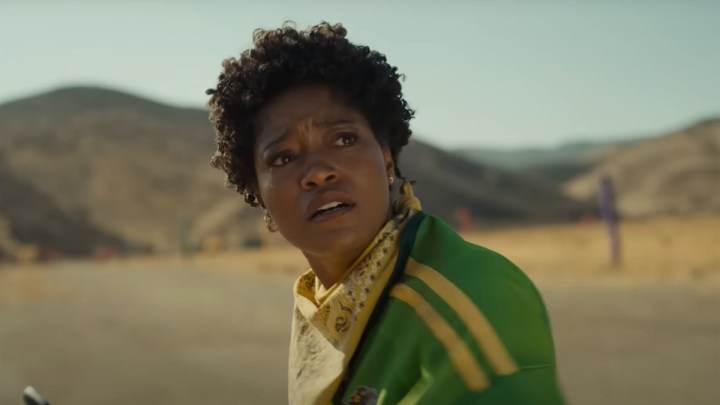Jordan Peele has never been defined by the genres he works within. One of the best things about Get Out and Us is that, while they are both horror movies to some extent, both movies push the boundaries of what is possible inside the narrow confines of that genre. They’re scary, but they’re also thought-provoking, funny, and thrilling. Peele’s mind is clearly a pretty strange, somewhat twisted place, and with Nope, we’re watching him take on the trappings of a different kind of film. Jordan Peele has made his first real blockbuster.
That’s not to say that Nope, which tells the story of a brother and sister who discover that a UFO has made its home over their ranch, doesn’t have elements of terror. Those moments are few and far between, though, and are eventually subsumed by the UFO itself, which dominates the film’s third act.
WARNING: Spoilers below for Nope.
Whatever you think of its quality, Nope is undoubtedly a movie about seeing and the dangers of being unable to deny visual spectacle. Whereas Us and Get Out use their first two acts to subtly build toward reveals that change the dynamics of what’s come before, Nope uses its earliest scenes to send its characters down a rabbit hole as they investigate the UFO that viewers are also intrigued by. This subtle shift moves things toward spectacle and away from outright horror, as Peele takes his time revealing not primarily a shift in the plot (although there is one of those), but what the UFO actually looks like.
As it turns out, the UFO is not a ship but a creature, and Peele and his collaborators are deliberate about showing off its design to the fullest possible effect. This is justified — the creature is just as mesmerizing as Peele knows it to be — but the alien itself and its implication are not in any way terrifying. The alien, affectionately nicknamed Jean Jacket by the movie’s central characters, is an animal and terrifying in the way predators can be. All you have to do, though, is look away.
More spectacle, less horror

Get Out and Us are, above all else, pretty neat. They have a central metaphor that Peele introduces, develops, and then brings to a satisfactory conclusion that is an ideal combination of provocative and thrilling. They are structured differently, but they resemble a movie like The Thing or any of John Carpenter’s early works. In Nope, though, Peele seems less interested in presenting a neat metaphor and more interested in creating a movie that’s more sprawling in scope and less focused.
In this way, the most natural point of comparison for Nope is not the horror films of John Carpenter, and instead something like Steven Spielberg’s Close Encounters of the Third Kind. Where Close Encounters is an optimistic work about the existential meaning behind an alien encounter, though, Nope is a bit more condemnatory of its audience. It’s a movie about how difficult we find it to look away from the horror that surrounds us, even when we know that we probably should.
While the Spielberg film it most resembles on a plot level is Close Encounters, it also has plenty in common with Jaws and Jurassic Park, two movies about the hubris of man and how impossible it is to tame the natural world. Nope is more in the Jurassic Park mold, though, because it loves the very spectacle that it condemns its audience for looking at.
This is not a flaw, per se. Peele is smart enough to know when his medium is contradicting his message, and in Nope, he seems content to live with that contradiction. His characters can look away, but Peele himself may be unable to.
The message is the medium

Perhaps because of its blockbuster trappings, it’s worth considering how Nope diverges from the character-driven stories that Peele told in his first two films. Get Out is built almost completely around Daniel Kaluuya, and we’re essentially riding through the movie right along with him. When he’s scared so are we, and when he’s moved to tears, it’s hard for us not to feel the same way.
Us functions in a similar way. Lupita Nyong’o’s daring dual performances are key to what the movie is doing, and while Peele takes plenty of time to show off his skills as a director, the movie is ultimately built around her work in those roles. Its central metaphor, and the reveal at its end, wouldn’t work at all if Nyong’o wasn’t there to anchor the whole affair.
In Nope, Peele reunites with Kaluuya, but for a role that is intentionally much less expressive than the one he played in Get Out. Here, Kaluuya plays someone who must be close to Peele’s platonic ideal of a man totally uninterested in spectacle. It’s Kaluuya’s OJ who figures out what the UFO really is, and he’s the one who understands that the alien is provoked by those who look at it.
Although Kaluuya gets his fair share of deserved action hero moments, OJ doesn’t have the depth that someone like Chris in Get Out. He’s ultimately a vehicle for Peele’s story, as is Keke Palmer’s Emerald, although Palmer delivers a terrific performance in the action star mold. There are some attempts at explaining who Emerald and OJ are and where they come from, but the story doesn’t need them to be hugely specific in order to work. It needs them to be interested in capturing imagery of Jean Jacket, and in some of the details of the horse ranch they run, which has a history that dates back to the earliest days of motion pictures.
Peele’s skill as a director allows him to wring great performances out of actors, even when the characters they’ve given are thin. Ultimately, though, Peele’s goal is to thrill and confuse his audience about whether they should be enjoying those thrills at all. Nope doesn’t have the kind of tidy metaphor that defines Us and Get Out, and it doesn’t have their scares either.
Instead, Peele’s directorial vision has been applied to a bigger scale than ever before, and that comes with certain sacrifices in tidiness and character development. When you’re making a blockbuster, though, that’s par for the course. But the result is one of the most original big screen entertainments in a while. Peele uses his wide canvas with great showmanship and intelligence, entertaining the audience while also subtly challenging their need for spectacle. What else would you expect from a director who, with only three movies, has established himself as a director whose talent is just as big as his brand.
Nope is currently playing in theaters.



